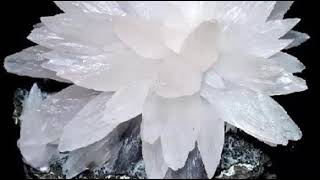What are the healing properties of calcite?
What are the healing properties of calcite?

Other polymorphs of calcium carbonate are the minerals aragonite and vaterite. Aragonite will change to calcite over timescales of days or less at temperatures exceeding 300 °C,[5][6] and vaterite is even less stable.
Contents
1 Etymology
2 Unit cell and Miller indices
3 Properties
3.1 Form
3.2 Hardness
3.3 Optical
3.4 Chemical
4 Use and applications
5 Natural occurrence
6 Formation processes
7 In Earth history
8 Gallery
9 See also
10 References
11 Further reading
Etymology
Calcite is derived from the German Calcit, a term coined in the 19th century from the Latin word for lime, calx (genitive calcis) with the suffix -ite used to name minerals. It is thus etymologically related to chalk.[7]
When applied by archaeologists and stone trade professionals, the term alabaster is used not just as in geology and mineralogy, where it is reserved for a variety of gypsum; but also for a similar-looking, translucent variety of fine-grained banded deposit of calcite.[8]
Unit cell and Miller indices
In publications, two different sets of Miller indices are used to describe directions in calcite crystals – the hexagonal system with three indices h, k, l and the rhombohedral system with four indices h, k, l, i. To add to the complications, there are also two definitions of unit cell for calcite. One, an older “morphological” unit cell, was inferred by measuring angles between faces of crystals and looking for the smallest numbers that fit. Later, a “structural” unit cell was determined using X-ray crystallography. The morphological unit cell has approximate dimensions a = 10 Å and c = 8.5 Å, while for the structural unit cell they are a = 5 Å and c = 17 Å. For the same orientation, c must be multiplied by 4 to convert from morphological to structural units. As an example, the cleavage is given as “perfect on ” in morphological coordinates and “perfect on ” in structural units. (In hexagonal indices, these are and .) Twinning, cleavage and crystal forms are always given in morphological units.[3][9]
Properties
Form
Over 800 forms of calcite crystals have been identified. Most common are scalenohedra, with faces in the hexagonal directions (morphological unit cell) or directions (structural unit cell); and rhombohedral, with faces in the or directions (the most common cleavage plane).[9] Habits include acute to obtuse rhombohedra, tabular forms, prisms, or various scalenohedra. Calcite exhibits several twinning types adding to the variety of observed forms. It may occur as fibrous, granular, lamellar, or compact. A fibrous, efflorescent form is known as lublinite.[10] Cleavage is usually in three directions parallel to the rhombohedron form. Its fracture is conchoidal, but difficult to obtain.
Scalenohedral faces are chiral and come in pairs with mirror-image symmetry; their growth can be influenced by interaction with chiral biomolecules such as L- and D-amino acids. Rhombohedral faces are achiral.
